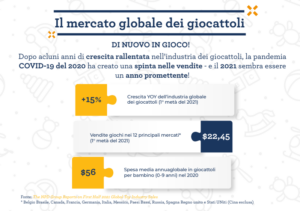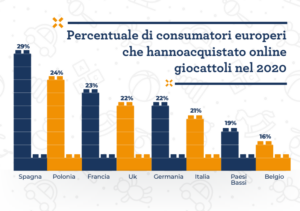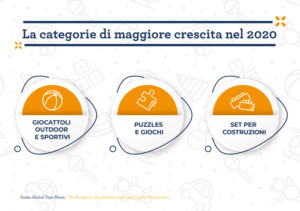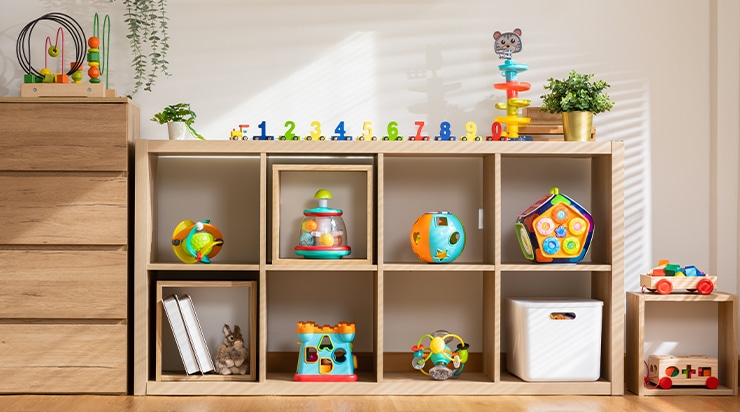Despite market challenges, the toy industry experienced significant growth between 2020 and 2021. The pandemic led to increased demand for home entertainment, as well as high-quality and ecological toys.
Toys are intended primarily, but not exclusively, for children’s entertainment. In general, the toy market can be divided into the following macro categories:
- Games and puzzles
- Outdoor and sports toys
- Toys for infants, toddlers, and preschoolers
- Dolls
- Construction sets
- Action figures and accessories
- Electronics for young people
- Vehicles
- Other toys
- Peluche
The toy market in Europe is the third largest market in terms of toy sales after North America and Asia. In 2020, the size of the European market was estimated at $24.6 billion. Annual spending on toys per child is estimated at $212 in Europe.
In 2020, the five largest European markets in terms of sales were:
- United Kingdom, with sales of about 3.8 billion euros
- Germany, with sales of about 3.6 billion euros.
- France, with a turnover of about 3.3 billion euros
- Italy, with a turnover of about 1.2 billion euros
- Spain, with a turnover of about 0.9 billion euros
According to data published by Assogiocattoli at the end of 2021, the Italian toy market ended 2021 in growth, marking +9% over 2020 (and +2.1% over 2019), concretely demonstrating how fundamental and essential the act of playing is.
As usual, the Christmas season weighs half of the Italian toys market turnover. According to data provided by research firm NPD*, the latest quarter (Oct./Dec. ’21) recorded a remarkable +6.7 percent over the previous one. Boxed games and construction toys continue to be among the best-selling products, confirming the return to play for older children – so-called kidults – thanks to game modes that can entertain and amuse everyone by eliminating any generation gap. Dolls also top the sales charts, followed by collectible products (Trading Card Game in primis), plush toys, wheeled vehicles, superheroes and dinosaurs.
Sales from licensed products account for 26 percent of the total market and are growing by +14 percent.

HOW THE TOY MARKET IS EVOLVING IN THE DIGITAL AGE
The Kids & Toys Observatory of the School of Management of the Politecnico di Milano, aims to analyze, in the toy industry, the needs of children and parents in the world of the digital age and support companies in sectors where children are the target audience to fully understand the impact of digital transformation.
In the digital age, the needs and behaviors of children and parents in the toy industry are changing: more than 1 in 3 parents search for information about toys to buy on the Internet or social networks, and 60% buy directly from smartphones. After an initial phase of searching for trends and inspirations, parents select tools and ways to investigate further: 66% look for information on forums/social networks and reviews, 19% ask for information in store, and 15% would rely on the smart shopping assistant who has already collected and selected all the information online.
It is a world in which advertising is still strongly linked to TV, but is proving to be increasingly digital: 93% of companies in the sector invest in advertising on Social.
The analysis of companies shows that the vast majority have a website and at least one social page that allows them to search for information about products and the company (97 percent) or to consult the catalog (83 percent).

59% of specialty stores only allow in-store shopping, 39% allow buying online and receiving at home, 29% allow buying online and picking up in-store, 22% allow buying in-store and receiving at home, and only 12% allow seeing the product in-store and buying it online.
Companies increasingly rely on third-party platforms such as marketplaces (83%), specialized retailer sites (63%), and large-scale retail sites (40%); private sales sites are also relied on in 33% of cases.
The post-sale experience
Fifty-seven percent of those who have made a purchase talk about it afterwards verbally to friends and family, 22 percent share on social networks, and 21 percent would like to automatically share their experience online in real time. But, despite the fact that almost all companies in the sample of businesses operating in Italy monitor their activities on social, it is difficult for most companies to value their impact on business (70% of cases). They typically measure basic KPIs (e.g., number of followers, post shares, likes, etc.) but only 13 percent of companies say they use social with the goal of having more information about the consumer from a CRM perspective. Moreover, if we consider that only 69% of stores have dedicated social channels and only 26% have active customer loyalty policies, it is interesting to consider this need as a new design space for companies.
What do children want?
Children prefer to play at home and in the park (74% and 32%), and most of them want to play with friends and parents (74% and 28%). Among the toy’s functionality, that of movement is recognized as a priority by children in all age groups (in 37% of cases in the 3-5 age group, 33% in the 6-8 age group, 28% in the 9-12 age group). Children in the 6-8 range put Apps in second place (26%), while those in the 9-12 range put voice command (23%).

HOW TO SELL TOYS ONLINE: AMAZON
Parents feel reassured by buying toys for their children on established online platforms such as Amazon. This is especially true if the product does not belong to a well-known brand.
To make the purchase of one’s own products attractive, within a competitive scenario as vast as that of amazon, it is necessary to consider certain aspects related to the creation of product sheets:
– use vibrant and very colorful images
– take photos from different angles and provide for close-up images of the smaller parts of the toy.
– Accompany the product with a detailed description. Indeed, this is the time when you need to be able to answer all the information a parent might need to be reassured: what age is it safe for? Are there smaller parts that could pose a choking hazard? What parts are/are not included (e.g., does it come with a remote control? are batteries included?), does the item have a warranty?
– it is not mandatory but strongly recommended to use the amazon logistics service, to fulfill orders within the timeframe and guarantees required by the marketplace.
Amazon, as is well known, is constantly trying to improve the shopping experience for users, and is very demanding in the requirements to be resettled in order to be accepted among sellers, particularly for this category, and in particular to gain eligibility to be allowed to sell toys during the Christmas season, which is the peak of sales.
Specifically for last Christmas 2021, it was necessary to meet certain performance requirements, such as: having made the first sale on the marketplace in a period prior to September 2020 (!), having achieved a percentage of pre-shipment cancellations of no more than 1.75% in the period between September 15 and October 14, 2020, having a percentage of late shipments of no more than 4%….
HOW TO GROW IN THE TOY MARKET?
The trends that will most drive the toy market and need to be taken into account in the coming years are as follows:
- Eco-sustainable toys: they are becoming increasingly popular. Manufacturing traditional toys, developing sustainable products from natural materials, and avoiding harmful substances such as glue, screws, or tapes because of the associated health and safety risks are all part of this trend. In addition, locally produced, recyclable plastic, rented and reused toys are on the rise.
- Quality over quantity: means that consumers value more expensive products and are willing to spend more money on fewer items. Sales volume in Europe is indeed decreasing slightly, but the average price is going up.
- Technology: which is revolutionizing the toy market. Children are becoming increasingly familiar and comfortable with digital content and technology. Toys with digital components now have the greatest appeal.
- Marketing investments: increasingly important to put in place. Creating an exceptional customer experience across all channels is critical. Younger buyers are particularly attracted to social media and video content. Therefore, winning toy brands should invest in virtual experiences, augmented reality, community-building, digital showrooms and hyper-personalization.
and of course ensure a plurality of touch points, increasingly digital, to intercept shoppers’ search.
